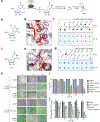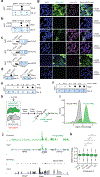An optimized chemical-genetic method for cell-specific metabolic labeling of RNA
- PMID: 32015544
- PMCID: PMC8518020
- DOI: 10.1038/s41592-019-0726-y
An optimized chemical-genetic method for cell-specific metabolic labeling of RNA
Abstract
Tissues and organs are composed of diverse cell types, which poses a major challenge for cell-type-specific profiling of gene expression. Current metabolic labeling methods rely on exogenous pyrimidine analogs that are only incorporated into RNA in cells expressing an exogenous enzyme. This approach assumes that off-target cells cannot incorporate these analogs. We disprove this assumption and identify and characterize the enzymatic pathways responsible for high background incorporation. We demonstrate that mammalian cells can incorporate uracil analogs and characterize the enzymatic pathways responsible for high background incorporation. To overcome these limitations, we developed a new small molecule-enzyme pair consisting of uridine/cytidine kinase 2 and 2'-azidouridine. We demonstrate that 2'-azidouridine is only incorporated in cells expressing uridine/cytidine kinase 2 and characterize selectivity mechanisms using molecular dynamics and X-ray crystallography. Furthermore, this pair can be used to purify and track RNA from specific cellular populations, making it ideal for high-resolution cell-specific RNA labeling. Overall, these results reveal new aspects of mammalian salvage pathways and serve as a new benchmark for designing, characterizing and evaluating methodologies for cell-specific labeling of biomolecules.
Figures





Similar articles
-
Profiles of pyrimidine biosynthesis, salvage and degradation in disks of potato (Solanum tuberosum L.) tubers.Planta. 2002 Sep;215(5):821-8. doi: 10.1007/s00425-002-0806-5. Epub 2002 Jun 21. Planta. 2002. PMID: 12244448
-
Enzymes of pyrimidine metabolism in Mycoplasma mycoides subsp. mycoides.J Bacteriol. 1979 Mar;137(3):1073-80. doi: 10.1128/jb.137.3.1073-1080.1979. J Bacteriol. 1979. PMID: 220209 Free PMC article.
-
Chemo-enzymatic synthesis of selectively ¹³C/¹⁵N-labeled RNA for NMR structural and dynamics studies.Methods Enzymol. 2014;549:133-62. doi: 10.1016/B978-0-12-801122-5.00007-6. Methods Enzymol. 2014. PMID: 25432748 Free PMC article.
-
Involvement of the uridine cytidine kinase 2 enzyme in cancer cell death: A molecular crosstalk between the enzyme and cellular apoptosis induction.Biomed Pharmacother. 2019 Jan;109:1506-1510. doi: 10.1016/j.biopha.2018.10.200. Epub 2018 Nov 14. Biomed Pharmacother. 2019. PMID: 30551402 Review.
-
Site directed mutagenesis as a tool to understand the catalytic mechanism of human cytidine deaminase.Protein Pept Lett. 2013 May;20(5):538-49. doi: 10.2174/0929866511320050007. Protein Pept Lett. 2013. PMID: 23033855 Review.
Cited by
-
An Optimized Enzyme-Nucleobase Pair Enables In Vivo RNA Metabolic Labeling with Improved Cell-Specificity.Biochemistry. 2022 Dec 6;61(23):2638-2642. doi: 10.1021/acs.biochem.2c00559. Epub 2022 Nov 16. Biochemistry. 2022. PMID: 36383486 Free PMC article.
-
3D convolutional neural networks predict cellular metabolic pathway use from fluorescence lifetime decay data.APL Bioeng. 2024 Feb 27;8(1):016112. doi: 10.1063/5.0188476. eCollection 2024 Mar. APL Bioeng. 2024. PMID: 38420625 Free PMC article.
-
Labelling of DNA and RNA in the cellular environment by means of bioorthogonal cycloaddition chemistry.RSC Chem Biol. 2020 Jun 2;1(3):86-97. doi: 10.1039/d0cb00047g. eCollection 2020 Aug 1. RSC Chem Biol. 2020. PMID: 34458750 Free PMC article. Review.
-
A Bump-Hole Strategy for Increased Stringency of Cell-Specific Metabolic Labeling of RNA.ACS Chem Biol. 2020 Dec 18;15(12):3099-3105. doi: 10.1021/acschembio.0c00755. Epub 2020 Nov 21. ACS Chem Biol. 2020. PMID: 33222436 Free PMC article.
-
Labeling and sequencing nucleic acid modifications using bio-orthogonal tools.RSC Chem Biol. 2022 Jun 22;3(8):994-1007. doi: 10.1039/d2cb00087c. eCollection 2022 Aug 3. RSC Chem Biol. 2022. PMID: 35975003 Free PMC article. Review.
References
References (Main Text)
-
- Jung J & Jung H. Methods to analyze cell type-specific gene expression profiles from heterogeneous cell populations. Anim Cells Syst 20, 113–117, doi:10.1080/19768354.2016.1191544 (2016). - DOI
References (Methods)
-
- Agarwal KC, Miech RP & Parks RE in Methods Enzymol. Vol. 51 483–490 (Academic Press, 1978). - PubMed
Publication types
MeSH terms
Substances
Grants and funding
- T34 GM069337/GM/NIGMS NIH HHS/United States
- 1DP2GM119164/U.S. Department of Health & Human Services | National Institutes of Health (NIH)/International
- R01 GM108889/GM/NIGMS NIH HHS/United States
- DP2 GM119164/GM/NIGMS NIH HHS/United States
- S10 RR025496/RR/NCRR NIH HHS/United States
- R21 MH113062/MH/NIMH NIH HHS/United States
- S10 OD010794/OD/NIH HHS/United States
- P30 CA062203/CA/NCI NIH HHS/United States
- 5R21MH113062/U.S. Department of Health & Human Services | National Institutes of Health (NIH)/International
- R25 GM055246/GM/NIGMS NIH HHS/United States
- S10 OD021718/OD/NIH HHS/United States
- 1R01GM108889-01/U.S. Department of Health & Human Services | National Institutes of Health (NIH)/International
LinkOut - more resources
Full Text Sources
Molecular Biology Databases

